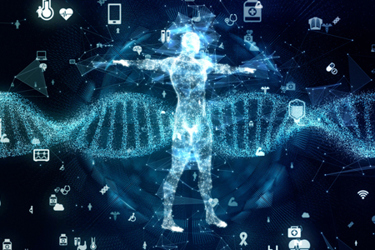Biosensing Technology: Where Is the Field Headed?
By Rob Batchelor, head of biosensors, Nutromics

Biosensing technologies have been used for decades in healthcare for such things as finger-stick glucose monitoring strips in the 1960s to urine-based pregnancy tests to wearable glucose monitors. All of these were revolutionary in their own right and improved patient care and awareness with each advancement. The next chapter in this story is being written now with breakthroughs in synthetic nucleic acid-based biosensors for precision diagnostics.
Nucleic acid-based biosensing is based on the intricate, specific molecular recognition process between nucleic acid (i.e., DNA or RNA) molecules and the desired molecular targets. Similar to proteins such as antibodies, DNA and RNA both possess the ability to specifically bind molecules of interest in complex biological fluids such as blood. This inherent trait forms the foundation for designing biosensors capable of detecting a wide range of analytes.
This article explores the science behind DNA-based biosensing and its practical applications in the field of healthcare and biomedical monitoring.
Biosensing Today: Consumer Adoption
Biosensors are commonly used in healthcare to monitor a broad range of conditions, including glucose monitoring, pregnancy status, and COVID status. A biosensor is a device that combines a biological component, such as DNA, enzymes, or antibodies, with a transducer to detect and convert a molecular response into a signal. The signal, typically optical or electrical, can then be processed and analyzed to provide information about a specific biological process or molecule.
Smart wearable devices, such as fitness trackers, use optical or electronic sensors to monitor various physiological parameters like your heart rate, blood oxygen levels, sweating, and even skin conductance. These sensors help you track your health and fitness levels in real time, providing data about workouts and daily activities. However, none of these devices are biosensors since they lack a biological sensing component.
The integration of a biological component (e.g., DNA) significantly increases a sensor’s “specificity.” In other words, the biological component allows the detection and quantitation of the desired molecule in a complex mixture.
For example, glucose monitors can measure glucose quite accurately in blood despite the presence of thousands of other molecules, some of them quite similar to glucose. Continuous glucose monitoring (CGM) devices have revolutionized diabetes management.
CGMs monitor blood glucose levels around the clock, providing information to help diabetics manage their condition effectively and make informed decisions about their diet, medication, and lifestyle. The CGM system consists of a small sensor that is inserted under the skin, usually on the abdomen or the back of the arm. This sensor contains a tiny, flexible electrode that measures the glucose levels in the interstitial fluid (ISF), which is the fluid surrounding the body’s cells.
The Next Evolution: Enter DNA-based Sensing
DNA-based sensing is a platform technology that can be used in a revolutionary way to track multiple targets continuously, providing real-time data. DNA-based biosensors can be designed using synthetic engineered DNA so that when they find their target, they change their shape.
How it works: DNA-based sensors, also known as aptamers, can be coated onto the surface of microneedles on a coin-sized wearable device that attaches to the arm. Each synthetic DNA strand remains unfolded until the desired molecule binds to the DNA. The binding event causes a shape change that is converted into an electrical current that is measured through electrochemistry.
Similar to how CGMs measure glucose in ISF in the body, the synthetic DNA-based sensor is designed to recognize targets of interest in interstitial fluid. However, instead of being limited to just measuring glucose, DNA-based sensors are capable of monitoring multiple targets, such as metabolites and medicines.
Applications In Diagnostics
DNA-based biosensors can be designed to measure the concentration of specific biomolecules, such as drugs or hormones, in patients' samples. This is essential for monitoring therapeutic drug levels in patients undergoing treatment. For example, DNA-based sensors are able to bind to the drug vancomycin, an antibiotic commonly used to treat life-threatening bacterial infections such as sepsis.
Another area where DNA-based sensors can have a major impact is the diagnosis of a heart attack. Troponin is a protein that is significantly elevated in the blood when the heart muscle is damaged, as in a heart attack. If someone comes into the emergency room suffering from chest pain, the current protocol includes testing for a rise and fall pattern of troponin to confirm the diagnosis, which can take several hours. Each minute after a heart attack, more heart tissue is damaged or dies. The continuous monitoring of troponin can provide early trend information, bringing diagnosis time down to mere minutes.
DNA-based biosensing technology has come a long way from its early beginnings, emerging as a transformative force in the healthcare industry. For instance, DNA-based biosensors can be integrated into portable point-of-care devices that enable rapid and on-site testing. This is particularly valuable in resource-limited or remote settings where access to centralized laboratories is limited.
Developing diagnostics and accelerating novel treatments are paramount to creating a more proactive healthcare system where clinicians and patients are empowered to make decisions based on molecular-level data. As research continues and technology evolves, even more innovative applications are expected that will further improve our understanding of health and disease, ultimately enhancing the quality of human life.
 About The Author:
About The Author:
Rob Batchelor is head of biosensors at Nutromics. He is an expert in aptamers, assays, and instrument development. You can connect with him on LinkedIn.
